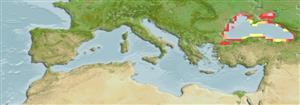>
Clupeiformes (Herrings) >
Ehiravidae (River sprats)
Etymology: Clupeonella: Latin, clupea = sardine, derived from Clupeus = shield; diminutive (Ref. 45335); cultriventris: "cultiventris" is taken from the Latin word, culter, meaning to cultivate. The ventral area of this fish is in the shape of a coulter, a vertical iron cutting blade fixed in front of a ploughshare (Ref. 72389).
Environment: milieu / climate zone / depth range / distribution range
นิเวศวิทยา
เกี่ยวกับทะเล,น้ำเค็ม; น้ำจืด; กร่อย; ปลาที่อพยพจากแหล่งน้ำเค็มไปวางไข่ในแหล่งน้ำจืด (Ref. 51243); ระดับความลึก 10 - 13 m (Ref. 10535). Temperate; 60°N - 36°N, 27°E - 56°E
Eurasia: Black Sea (northwestern parts), Sea of Azov and Caspian Sea, also most of the affluent rivers of the area, reaching as far as 60 km inland. Also, Lake Palaeostomi (Bulgaria) and in Bay of Feodosiya (Romania), also Lake Apolyont (Turkey) (Ref. 188). Previously, two subspecies were recognized by some: Clupeonella cultriventris cultriventris (Nordmann, 1840) from the Black Sea and the Sea of Azov and Clupeonella cultriventris caspia (Svetovidov, 1941) from the Caspian Sea (Ref. 26334, 39702).
ขนาด / น้ำหนัก / Age
Maturity: Lm ? range ? - ? cm
Max length : 14.5 cm TL เพศผู้/กระเทย; (Ref. 72389); common length : 10.0 cm SL เพศผู้/กระเทย; (Ref. 188); อายุสูงสุดที่ได้รายงาน: 5 ปี (Ref. 10535)
เงี่ยงครีบหลัง (รวม): 0; ก้านครีบอ่อนที่หาง (รวม): 13-21; เงี่ยงครีบก้น 0; ก้านครีบอ่อนที่ก้น: 12 - 23. Head short and wide; belly sharply keeled, with 24 to 29 scutes; pectoral fin tips pointed; last 2 anal fin rays enlarged; pterotic bulla absent; no notch at the center of the upper jaw. Based on pelvic and pectoral fin length, Svetovidov (1952 and 1963) recognized 2 subspecies: C. cultriventris cultriventris with longer pectoral and pelvic fins compared to that of C. cultriventris caspia.
Essentially a brackish water species but tolerating salinities up to 34 ppt and with semi-anadromous and purely freshwater forms in rivers and lakes. Forms schools. Migratory between winter or autumn feeding and summer spawning grounds. Feeds on zooplankton (Ref. 188); crustaceans such as copepods and cladocerans (Ref. 59043). Breeds in early summer in the Sea of Azov with a peak in May, and from about May in the lower reaches of rivers (e.g. Dneiper and Dneister) (Ref. 188). Eggs are pelagic (Ref. 59043).
Whitehead, P.J.P., 1985. FAO Species Catalogue. Vol. 7. Clupeoid fishes of the world (suborder Clupeoidei). An annotated and illustrated catalogue of the herrings, sardines, pilchards, sprats, shads, anchovies and wolf-herrings. FAO Fish. Synop. 125(7/1):1-303. Rome: FAO. (Ref. 188)
IUCN Red List Status (Ref. 130435)
Threat to humans
Harmless
Human uses
การประมง: เน้นการพาณิชย์
ข้อมูลเพิ่มเติม
อ้างอิงการเพาะเลี้ยงสัตว์น้ำประวัติการเพาะเลี้ยงสัตว์น้ำสายพันธุ์พันธุศาสตร์ElectrophoresesอัตราพันธุกรรมโรคการแปรรูปNutrientsMass conversion
ผู้ร่วมมือรูปภาพหลายรูปStamps, Coins Misc.เสียงปลามีพิษ เช่น ปลาปักเป้าความเร็วรูปแบบการว่ายน้ำพื้นที่เหงือกOtolithsสมองวิสัยทัศน์
เครื่องมือ
Special reports
Download XML
แหล่งที่มาจากอินเตอร์เน็ต
Estimates based on models
Preferred temperature (Ref.
123201): 13.5 - 16.5, mean 14.8 °C (based on 130 cells).
Phylogenetic diversity index (Ref.
82804): PD
50 = 0.5078 [Uniqueness, from 0.5 = low to 2.0 = high].
Bayesian length-weight: a=0.00759 (0.00362 - 0.01590), b=3.06 (2.88 - 3.24), in cm total length, based on LWR estimates for this species & (Sub)family-body (Ref.
93245).
ระดับชั้นอาหาร (Ref.
69278): 3.0 ±0.0 se; based on diet studies.
ความสามารถในการกลับคืนสู่ปกติ (Ref.
120179): ขนาดกลาง, เวลาต่ำสุดที่จะทำให้ประชากรเพิ่มขึ้นเป็น 2 เท่าใช้เวลา 1.4 - 4.4 ปี (K=0.2-1.1(?); tm=2-3; tmax=5; Fec=5,220-20,110).
Fishing Vulnerability (Ref.
59153): Moderate vulnerability (35 of 100).
Climate Vulnerability (Ref.
125649): High vulnerability (60 of 100).
Nutrients (Ref.
124155): Calcium = 39.7 [14.4, 148.7] mg/100g; Iron = 0.303 [0.112, 1.137] mg/100g; Protein = 18.6 [16.8, 20.6] %; Omega3 = 0.937 [0.472, 1.929] g/100g; Selenium = 2.05 [0.71, 7.26] μg/100g; VitaminA = 46 [15, 144] μg/100g; Zinc = 0.597 [0.351, 1.704] mg/100g (wet weight); based on
nutrient studies.
